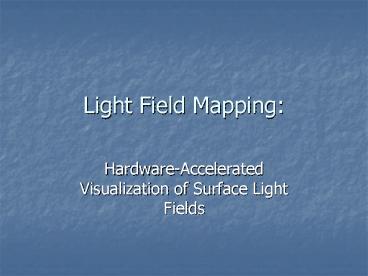Light Field Mapping: - PowerPoint PPT Presentation
Title:
Light Field Mapping:
Description:
Defines radiance of every point on surface of an object in every viewing direction ... T azimuth angle. F elevation angle. This is the triangle light field ... – PowerPoint PPT presentation
Number of Views:65
Avg rating:3.0/5.0
Title: Light Field Mapping:
1
Light Field Mapping
- Hardware-Accelerated Visualization of Surface
Light Fields
2
(No Transcript)
3
What is a Surface Light Field?
- 4-D Function f (r, s, T, F)
- Defines radiance of every point on surface of an
object in every viewing direction - (r,s) Describe surface location
- (T, F) Describe viewing location
- In practice, almost always discrete
4
Proposed Approach
- f (r, s, T, F) ? gk(r,s) hk(T, F) (eq 1)
5
Surface Light Field Approximation
- Approximation algorithms assume data given as 4-D
grid - f (rp, sp, Tq, Fq)
- p 1, , M discrete values of surface location
- q 1, , N discrete values of viewing angles
6
Surface Light Field Approximation
- f (rp, sp, Tq, Fq) ? gk(rp,sp) hk(Tq, Fq) (eq
2) - Only practical if of terms is small
- Difficult to find good approximation to complete
SLF using few summation terms
7
Surface Light Field Approximation
- Instead, surface of object partitioned into
smaller units - By decomposing SLF of each unit, close
approximation of original data obtained - Allows for efficient storage and fast rendering
8
Using Singular Value Decomposition
- Use SVD to factor SLF
- This method more robust, optimal
- To apply, 4D SLF must be rearranged into matrix
9
Approximation Through SVD
- F P USVT
- U square matrix (uk)
- V square matrix (vk)
- S diagonal matrix (sk)
- USVT ?skukvkT (eq 4)
10
Triangle-Centered Approximation
- Partition light field function into individual
triangles - f (r, s, T, F) ? ??i (r,s) f (r, s, T, F) (eq
5) - T azimuth angle
- F elevation angle
- This is the triangle light field
- When rendered, produces visible discontinuities
at triangle edges
11
(No Transcript)
12
Vertex-Centered Approximation
- To eliminate discontinuities, partition SLF
around every vertex - f (r, s, T, F) ? ?vj (r,s) f (r, s, T, F) (eq
8) - In this method, each triangle shares light field
maps with neighboring triangles
13
Representation of Light Field Maps
- 2D texture representation of surface map as Gk
(s,t) - 2D texture representation of view map as Hk (x,y)
- Texture coordinate computation
- X(dx 1) /2 (eq 13)
- Y(dy 1) /2
14
(No Transcript)
15
Rendering Algorithm
- Triangle-centered vertex centered approaches
differ only in how each individual approximation
term is evaluated - Surface map coordinates for both do not need to
be recomputed - View map coordinates recomputed every time view
changes
16
Rendering Algorithm
- Now evaluate kth approximation term
- Triangle-centered multiply pixel-by-pixel image
projections of 2 texture fragments - Vertex-centered multiply pixel-by-pixel 3 pairs
of light field maps from each vertex and add
together
17
(No Transcript)
18
Hardware Accelerated Implementation
- Pixel-by-pixel approach (modulation)
multiplication of surface map fragment by view
map fragment - Multitexturing hardware support allows for
effective modulation of two texture fragments in
one rendering pass - K-term approximation
- K rendering passes for triangle-centered
- 3K rendering passes for vertex-centered
19
Data Acquisition
- First images are captured under fixed lighting
conditions (200-400 images) - Object geometry is computed through structured
lighting system consisting of projector and
camera(10-20 scans) - Scans are registered together in same reference
frame used for image registration - Resulting points fed into mesh editing software
- Finally, mesh is projected onto camera image
20
(No Transcript)































